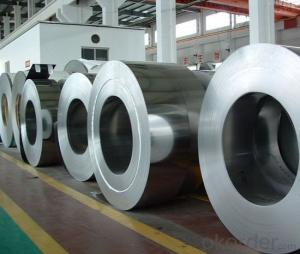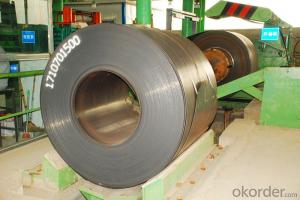Hot Rolled Stainless Steel Coil 201 Narrow Strip
OKorder Service Pledge
OKorder Financial Service
You Might Also Like
Hot Rolled Stainless Steel Coil 201 No.1 Finish Narrow Strip
Hot Rolled Stainless Steel 201 half copper Chemical Composition(%) | |||||||
C | Si | Mn | P | S | Ni | Cr | Cu |
0.1 | 0.5 | 10 | 0.04 | 0.01 | 1.20/1.30 | 13.00/14.00 | 0.8/1.0 |
Grade: | 200 Series | Standard: | JIS,AISI,ASTM,GB,DIN | Thickness: | 2.5/3.0/4.0mm |
Width: | 485/510/550/610/1010/1240mm | Place of Origin: | Shanghai China (Mainland) | Brand Name: | CNBM |
Model Number: | 201 | Technique: | Hot Rolled | Application: | Industrial tubes/kitchen/bath |
Certification: | ISO | THK: | 2.5/3.0/4.0mm | Face: | No.1 |
Usage: | tubes/kitchen/bath | Origin: | CHINA | ||
201 Hot Rolled Stainless Steel Coil Specifications
THK:2.3/2.5/3.0/4.0mm
Width:485/510/550mm
Face:No.1
201 Hot rolled stainless steel Coil Application
Stainless steel is a production which not easy rust,acid resistance and corrosion resistance,so it is widely
used in light industry,heavy industry,daily necessities and the decoration industry.201 hot rolled stainless steel coil, use to produce cold rolled stainless ste
-el coil and stainless steel tube, pipe.
201 Hot Rolled Stainless Steel Coil
Strength Of Extension:100,000 To 180,000 Psi;
Yield Strength:50,000 To 150,000 Psi
Elongation :55 To 60%;
Modulus Of Elasticity:29,000,000 Psi;
Density :.280lbs/Cubic Inch(7.93g/Cm3)
- Q:How do stainless steel strips handle exposure to acids?
- Stainless steel strips are highly resistant to the corrosive effects of acids. This is due to the presence of chromium in the composition of stainless steel, which forms a protective oxide layer on the surface of the metal. This oxide layer acts as a barrier, preventing the acid from coming into direct contact with the steel and thereby reducing the risk of corrosion. Additionally, stainless steel also contains other alloying elements such as nickel and molybdenum that further enhance its resistance to acids. However, it is important to note that the performance of stainless steel strips can vary depending on the specific type and concentration of acid being exposed to. In some cases, certain aggressive acids may still cause some degree of corrosion, especially at elevated temperatures or prolonged exposure. Therefore, it is advisable to consult with a corrosion specialist or refer to specific guidelines to ensure the appropriate grade of stainless steel is chosen for a particular acid exposure application.
- Q:Can stainless steel strips be used in the production of marine propellers?
- Marine propellers can benefit greatly from the inclusion of stainless steel strips. This material is widely favored in marine applications because of its remarkable ability to resist corrosion and endure harsh conditions. Propellers in particular face the constant threat of degradation and corrosion due to exposure to saltwater. However, by incorporating stainless steel strips, propellers can effectively withstand the corrosive effects of saltwater, leading to enhanced longevity and superior performance. Moreover, stainless steel boasts exceptional strength and fatigue resistance, making it an ideal choice for propeller blades that must endure the forces and vibrations associated with marine propulsion. All in all, stainless steel strips are a suitable and practical option for the production of marine propellers, given their resistance to corrosion, durability, and strength.
- Q:How do stainless steel strips resist erosion in abrasive environments?
- Stainless steel strips resist erosion in abrasive environments due to their unique composition and protective oxide layer. The high levels of chromium present in stainless steel form a passive film on the surface, which acts as a barrier against corrosion and prevents direct contact of the metal with the abrasive materials. This oxide layer is self-healing, meaning it can repair itself if damaged, further enhancing the steel's resistance to erosion. Additionally, stainless steel's high strength and hardness make it more resistant to wear and tear, allowing it to withstand the abrasive forces present in harsh environments.
- Q:How do stainless steel strips handle exposure to chlorine?
- Stainless steel strips are highly resistant to corrosion and can handle exposure to chlorine quite effectively. Chlorine is a highly reactive element and can cause corrosion in many metals, but stainless steel contains a high amount of chromium which forms a protective oxide layer on its surface. This oxide layer acts as a barrier, preventing chlorine from reaching the underlying metal and thus protecting the stainless steel strip from corrosion. Additionally, stainless steel also contains other alloying elements like nickel and molybdenum, which further enhance its resistance to corrosion in chlorine-rich environments. Overall, stainless steel strips are an excellent choice for applications that involve exposure to chlorine, as they can maintain their strength and integrity even in harsh conditions.
- Q:Are stainless steel strips suitable for furnace parts?
- Yes, stainless steel strips are suitable for furnace parts. Stainless steel is known for its high heat resistance, durability, and corrosion resistance, making it a suitable material for furnace parts that are exposed to high temperatures and harsh environments.
- Q:What are the different types of welding processes used for stainless steel strips?
- There are several types of welding processes commonly used for stainless steel strips, including TIG (Tungsten Inert Gas) welding, MIG (Metal Inert Gas) welding, and laser welding. TIG welding is known for its precision and produces high-quality welds, making it suitable for thin stainless steel strips. MIG welding is faster and more versatile, making it ideal for thicker stainless steel strips. Laser welding is a non-contact process that offers high-speed and high-quality welds, often used in automated production lines for stainless steel strips.
- Q:How do stainless steel strips handle thermal expansion and contraction?
- Stainless steel strips are known for their excellent thermal expansion and contraction handling capabilities. Due to the nature of stainless steel, which is a highly stable and resilient material, it can withstand extreme temperature changes without significant distortion or damage. When exposed to heat, stainless steel strips expand gradually and uniformly, allowing them to maintain their shape and structural integrity. This expansion is relatively low compared to other metals, which reduces the risk of warping or buckling. Similarly, when subjected to cold temperatures, stainless steel strips contract evenly, ensuring they can adapt to the changing conditions without compromising their strength. The exceptional thermal expansion and contraction properties of stainless steel strips make them suitable for various applications, particularly those involving temperature fluctuations. This includes industries such as construction, automotive, aerospace, and manufacturing, where the material is commonly used for structural components, fasteners, and heat exchangers. It is important to note that while stainless steel is highly resistant to thermal expansion and contraction, it is not entirely immune to the effects of extreme temperature changes. Proper engineering and design considerations should always be taken into account to ensure the material's performance is optimized and potential issues are minimized.
- Q:What are the different types of slitting for stainless steel strips?
- There are several different types of slitting techniques for stainless steel strips, including rotary slitting, loop slitting, and pull-through slitting. Each method has its own advantages and is suited for different applications. Rotary slitting involves using a rotating circular blade to cut the stainless steel strip into narrower strips. Loop slitting involves feeding the strip through a loop and utilizing two rotating circular blades to cut the strip. Pull-through slitting, on the other hand, uses a set of tensioned rolls to pull the strip through a set of knives, resulting in precise and accurate cuts. The choice of slitting technique depends on factors such as strip thickness, width requirements, and desired edge quality.
- Q:What are the different types of surface coatings for stainless steel strips?
- There are several different types of surface coatings available for stainless steel strips, each with its own unique characteristics and benefits. Some of the most common types include: 1. Passivation: This process involves treating the stainless steel surface with an acidic solution to remove any contaminants and promote the formation of a passive oxide layer. Passivation helps to enhance the corrosion resistance of stainless steel and improve its appearance. 2. Electroplating: Electroplating involves depositing a layer of metal onto the stainless steel surface through an electrochemical process. This coating can provide decorative finishes, such as gold or chrome plating, as well as enhance the corrosion resistance of the stainless steel. 3. Powder coating: Powder coating involves applying a dry powder to the stainless steel surface, which is then cured under heat to form a protective coating. This coating is available in a wide range of colors and finishes and provides excellent durability and resistance to corrosion, chemicals, and UV rays. 4. PVD coating: Physical vapor deposition (PVD) is a process where a thin film of metal is deposited onto the stainless steel surface through vaporization in a vacuum chamber. This coating offers excellent adhesion, hardness, and wear resistance, and can provide a variety of decorative and functional finishes. 5. Paint coating: Stainless steel strips can also be coated with paint to provide a protective barrier against corrosion and environmental elements. Paint coatings are available in various colors and can be customized to provide specific properties such as high heat resistance or resistance to chemicals. 6. Ceramic coating: Ceramic coatings are applied to stainless steel strips to provide a hard, durable, and heat-resistant surface. These coatings offer excellent abrasion resistance and can provide a smooth and glossy finish. It is important to consider the specific requirements and applications of the stainless steel strips when choosing the appropriate surface coating. Factors such as corrosion resistance, appearance, durability, and functionality should be taken into account to ensure the desired performance and longevity of the coated stainless steel strips.
- Q:What are the different types of corrosion that can affect stainless steel strips?
- There are several types of corrosion that can affect stainless steel strips, including pitting corrosion, crevice corrosion, galvanic corrosion, stress corrosion cracking, and intergranular corrosion.
1. Manufacturer Overview |
|
|---|---|
| Location | |
| Year Established | |
| Annual Output Value | |
| Main Markets | |
| Company Certifications | |
2. Manufacturer Certificates |
|
|---|---|
| a) Certification Name | |
| Range | |
| Reference | |
| Validity Period | |
3. Manufacturer Capability |
|
|---|---|
| a)Trade Capacity | |
| Nearest Port | |
| Export Percentage | |
| No.of Employees in Trade Department | |
| Language Spoken: | |
| b)Factory Information | |
| Factory Size: | |
| No. of Production Lines | |
| Contract Manufacturing | |
| Product Price Range | |
Send your message to us
Hot Rolled Stainless Steel Coil 201 Narrow Strip
OKorder Service Pledge
OKorder Financial Service
Similar products
New products
Hot products
Related keywords






























